
Decoding the Bible: How Close Are We to the Original Text?
Many believers often wonder whether their modern Bibles reflect what the original authors wrote. With centuries of translations and transcriptions, it’s a valid question that hinges on the intricate balance between accuracy and readability. The history of biblical translations is complex—since Tyndale's first English translation in 1526, there have been approximately 900 different English versions. This evolution begs curiosity: Are any of these translations genuinely reflective of the original texts?
The Translation Challenge: Balancing Faithfulness and Readability
Scholarly translators are tasked with a difficult balancing act: they aim to remain true to the wording and intent of ancient Hebrew, Greek, or Aramaic texts while ensuring that the result is accessible and understandable for contemporary readers. The discussions around translations like the New International Version (NIV) and the New Living Translation (NLT) illustrate the variances in approach. For example, John 3:16 in these translations captures essential truths, yet their wording varies significantly, showcasing the need to focus on contextual meaning.
Accuracy in Translation: The Real Picture
Some argue that translations muddle the original intent of the Scriptures, leading to misunderstandings. However, entities like BibleProject emphasize an essential point: while no translation can perfect each nuance, reading multiple translations can enhance our understanding of key concepts. This iterative approach allows believers not only to engage with Scripture through different lenses but also to grasp the richness of biblical language.
Common Misconceptions About the Bible's Reliability
Many skeptics assert that the Bible’s reliability suffers due to excessive translations, suggesting that modern readers are experiencing copies of copies. As Tim Barnett of Stand to Reason counters, the majority of recent English translations stem directly from original texts rather than existing translations. This fact, often lost in discussions, is fundamental for both believers and skeptics; our modern access to the Bible allows us to connect back to these original texts.
The Role of Translation in Cultivating Faith
For believers, having various translations should not breed doubt but rather inspire a deeper inquiry into the Scriptures. Each version serves as a tool to explore God's word in richer, more meaningful ways. For youth and college students looking to solidify their faith, understanding the history behind translations can be incredibly enlightening. It opens pathways for critical thinking and examination of one's beliefs.
Encouragement to Explore Different Translations
As the landscape of religious thought expands, so does the importance of exploring different Bible translations. For parents educating their children about faith, exposing them to multiple translations fosters an environment of inquiry and understanding. It prepares them to grapple with diverse perspectives, urging them to seek context and meaning behind biblical texts.
The journey of understanding the Scriptures is filled with opportunities for deeper engagement. Whether you are a skeptic or a seeker, there is immense value in reading and discussing various translations of the Bible. By doing so, believers can bolster their faith while those on the fence can make well-informed decisions about theological perspectives.
Call to Action: Engage with the Text
Take the opportunity to explore multiple Bible translations for yourself. Dive into discussions with your community or join local study groups that explore the Scriptures together. This communal approach not only enhances understanding but strengthens the bonds within your faith community. Challenge yourself to read critically and embrace the nuances of biblical texts.
 Add Row
Add Row  Add
Add 








Write A Comment